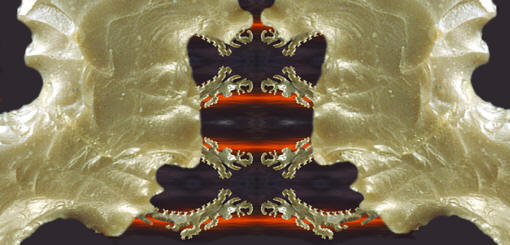|
"The situation
(when trying to distinguish different
animals in Mayan mythology) is made even
more difficult when artists create hybrid creatures which combine
crocodilian features with snake and dragon characteristics, with added
horns for good measure."---2006,
Hope B. Werness, "Animal Symbolism In Art, pp. 119-120.
"Some eccentrics are fashioned to represent human heads in
profile.---The 6th century Copan temple that archaeologists call the "Rosalila
structure" contained a large cache of chipped flints, including a number
of human profiles."---2008, Charles
Phillips, "The Complete Illustrated History Of The Aztec & Maya," p.
480.
"Flint-chipping reached the perfection of a
fine art among the ancient Maya----. Sub-stela caches of
eccentric-shaped flints and blades are frequently found buried in the
foundations of many Maya monuments"---1947,
Sylvanus Griswold Morley, "The Ancient Maya," p. 136.
"Perhaps the finest examples of this
(Mayan) craft that have come down to us are the exceedingly elaborate
yet delicately chipped heads for ceremonial staffs which were excavated
at El Palmar in Quintana Roo."---1947,
Sylvanus Grisworld Morley, "The Ancient Maya," p. 136.
The records
left by those ancient Americans, the Aztecs, Mays, and the Incans, tell
us nothing of the origin of maize except in the form of various highly
implausible myths."---1974, Paul C.
Mangelsdorf, "Corn, Its Origin Evolution And Improvement," p. 3.

A COMPLEX MAYAN
ECCENTRIC
REPLICATED BY DAN THEUS
THE ORIGINAL IS LATE CLASSIC PERIOD
A.D. 600-900
MEXICO OR GUATEMALA
Large numbers of Mayan eccentrics have been found in
every conceivable shape.
They have been discovered in important tombs and in offertory caches under temples and monuments.
But only a small number have been found that would compare to the elaborate example
illustrated here.
This is one of the more complex eccentrics that has ever been found. As far as craftsmanship is
concerned it probably rates somewhere in the top 10%. Any ancient or
modern flintknapper that can produce complex forms like this must not
only have a high degree of skill but an extra measure of patience.
|
|
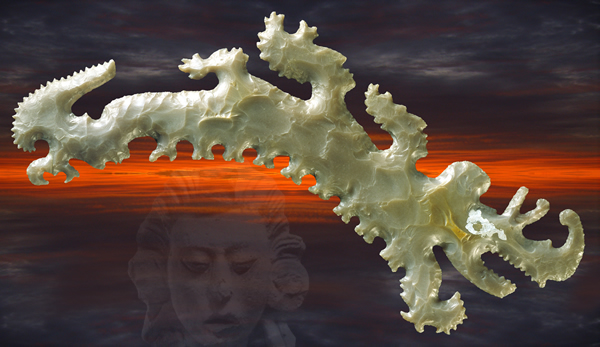
"ESCORT TO THE UNDERWORLD"
MAYAN CROCODILE CANOE
DIVING INTO THE UNDERWORLD
MODERN COPY OF ORIGINAL BY DAN
THEUS
This image actually represents a conveyance. The stylized crocodile
head at the front of the "canoe" is diving down into the Maya
underworld carrying with it the soul of the Maize god, also known as
the First Father. The canoe is paddled by the gods with such great
force that all three passengers on the top are
thrust backwards from the force of the dive. The journey takes the
First Father to the Place of Creation where he comes back to life
again as the Maize god. It is interesting that the Maya gives a
specific date of August 13, 3114 B.C. as the day of creation.
This is a very accurate copy of the original made by Dan
Theus. Although it is smaller than the original. This one measures
11 3/4 inches (29.8 cm) long, 5 inches (12.7 cm) wide and 9/16 inch
(1.4 cm) thick and it's made of light brown Texas Pedernales chert. |
|
|
This complex eccentric illustrates a portion of Mayan mythology that
involves the rebirth of the maize god. The maize god is associated with
abundance and prosperity and is represented with youthful features as
the Maya idea of beauty. The maize god appears prominently in Maya art
during the Classic period between the years 200 B.C. and A.D. 900.
According to the Quiche Maya, as recorded in their book called Popol Vuh,
the gods created humans out of yellow and white corn (maize). Attempts
with mud and wood were unsuccessful. |
|
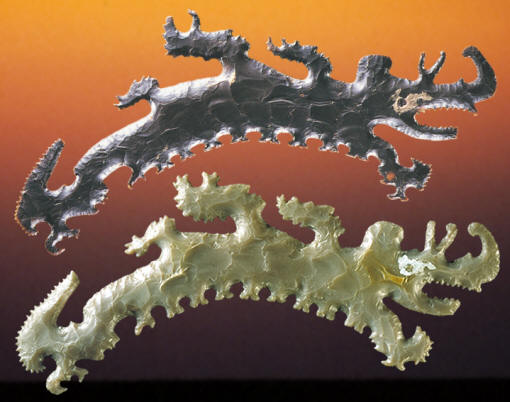
CLICK ON PICTURE FOR LARGER IMAGE
MAYAN ECCENTRICS
COMPARISON OF REPLICA TO ORIGINAL
This picture compares the original
crocodile canoe eccentric located above to the one below that was
made by Dan Theus. One addition on the copy is the use of white-out to color
the area around the eye which is natural to the stone on the
original. Another difference is the size. Dan's replica measures
11 3/4 inches (29.8 cm) long, 5 inches (12.7 cm) wide and 9/16 inch
(1.4 cm) thick. The original artifact at top measures 16 3/16 inches
(41.1 cm) long, 9 3/4 inches (24.7 cm) wide and 1 1/16 inch (1.7 cm)
thick. Both eccentrics were made from good quality cherts that have
similar flaking qualities. |
|
|
Ancient cultures around the
world have used astronomy in one way or another in various forms of
storytelling mythology. Mayan astronomy was used to describe the
creation story of the maize god. The movement of the stars created an
annual reenactment of the event. The Milky Way was the object in the sky
that was described as the cosmic monster. The starry light arched across
the sky on August 13th and dove downward into the spirit world where the
spirit of First Father received the flesh of humanity and was reborn
again as the maize god. |
|
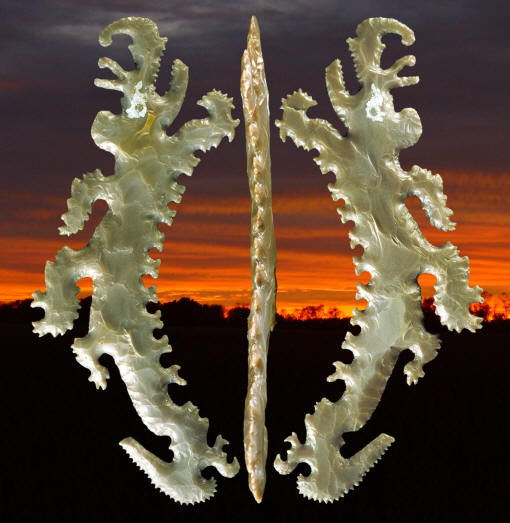
CLICK ON PICTURE FOR LARGER IMAGE
"ESCORT TO THE UNDERWORLD"
MAYAN CROCODILE CANOE
MODERN COPY OF ORIGINAL BY DAN
THEUS
This
picture shows all three views of the Dan Theus "crocodile canoe."
The Hybrid" stylized crocodile head is at the top, complete with
horns. On the back or "in the canoe" are three human profiles. The
largest one in the center is presumably the First Father that will
be transformed or reborn into the Maize god. The end of the tail at
the "stern of the canoe" is another human profile representing
another important elite figure. A fifth human profile is located at
the end of the front leg of the crocodile. It has been suggested
that the row of stylish
notches on the bottom might represent knots on a mummy case. It
measures 11 3/4 inches (29.8 cm) long, 5 inches (12.7 cm) wide and
9/16 inch (1.4 cm) thick and is made of light brown Texas Pedernales chert. |
|
|
This Mayan eccentric has been described as representing a canoe
with an open mouthed crocodile on the prow. The crocodile image is
fiercely represented in an abstract form with horns and a dramatically
upturned nose. Five human profiles are located
at different points along the edge. One is located
at the front, one at the back and three on the top. The combined images illustrates a portion of the Mayan story of creation at the moment when
the crocodile god is diving down with his elite passengers into the
underworld. |
|
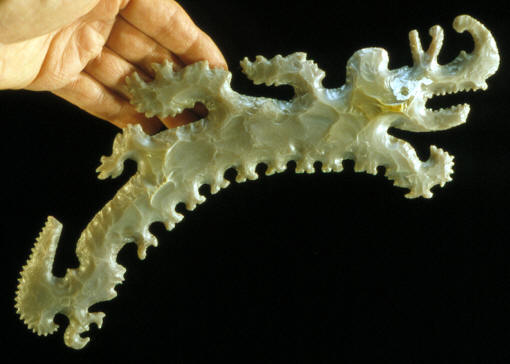
"ESCORT TO THE UNDERWORLD"
MAYAN CROCODILE CANOE
MODERN COPY OF ORIGINAL BY DAN
THEUS
This picture illustrates
the size of the Dan Theus crocodile canoe eccentric. It measures
113/4 inches (29.8 cm) long, 5 inches (12.7 cm) wide and 9/16 inch
(1.4 cm) thick and is made of light brown Texas Pedernales chert. |
|
|
The original crocodile
canoe is larger than Dan's example. It measures 16 3/16 inches (41.1 cm)
long, 9 3/4 inches (24.7 cm) wide and 11/16 inch (1.7 cm) thick. Dan's
replica measures 11 3/4 inches (29.8 cm) long, 5 inches (12.7 cm) wide
and 9/16 inch (1.4 cm) thick. Most eccentrics seem to range in size from
2 1/2 inches (6.3 cm) to 4 1/2 (11.5 cm) inches long. Penderdergast
reported eccentrics found at Altun Ha and Lamanai in Belize as large as
30 11/16 inches (78 cm) long. Both of the eccentrics in this picture
were made from good quality cherts. The original eccentric is made of a
dark brown chert and Dan's copy is made of a lighter brown Texas
Pedernales chert. |
|
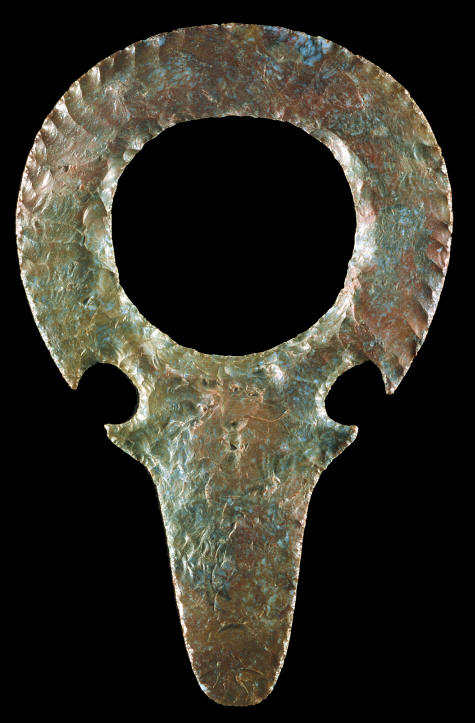
MAYAN ECCENTRIC
MADE BY DAN THEUS
This large Mayan perforated staff
head is another example Dan Theus' work. Ancient examples that look
like this one have been
found in northeastern Belize near the town of Altun Ha on a site
also by that name. Elaborate perforated examples like this one have
also been discovered on other Maya sites. Variations on this design
have extra notches on the edge and a wavy serpentine handle. This
modern copy is thin and very well flaked and measures 8 inches (20.3
cm) long. |
|
|
The
Dan Theus crocodile canoe
took 47 hours to make. But that was after three previous attempts. So
the total time involved to complete the project was 200 hours. Dan is
currently the only person to have made a replica of the original. He
made it from a 14 inch long percussion flaked
biface that was further shaped along the edge with punch flaking and
pressure flaking touch up. Most of the time was spent doing punch
flaking. |
|
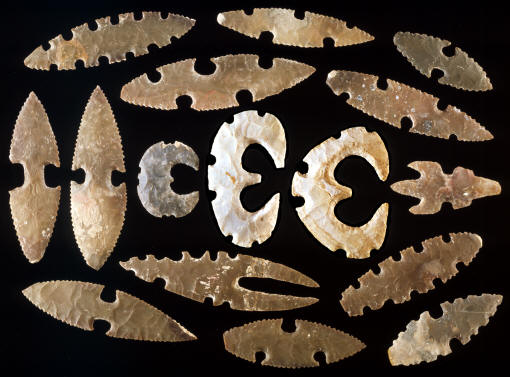
CLICK ON PICTURE FOR LARGER IMAGE
MAYAN ECCENTRICS
This picture illustrates a few more examples of Mayan eccentrics.
These less complex forms represent the largest percentage of
eccentrics that have been found. Most Mayan eccentrics do not
approach the complexity of the crocodile canoe illustrated in this
article. |
|
|
The direction that
modern flintknapping
has taken over the last 30 years is pretty amazing. Before 1975,
most of the larger flaked pieces made in the modern era were
either made from old broken artifacts that were rechipped along the
edges or made from thin sawed blanks that were flaked with various types
of mechanical devices. As the years go by, artisans like Dan Theus
continue to copy or replicate more and more of the most advanced
examples of ancient lithic artifacts. At this point it seems that the only
limitation of what can be duplicated is the availability of very large
pieces of chert for flintknappers to work with. One thing is for sure,
Dan's crocodile canoe eccentric is one of the most complex lithic pieces
that has been made by any of today's modern knappers. |
|
"REFERENCES"
1947, Morley, Sylvanus Griswold, "The Ancient Maya," p. 136.
1974, Mangelsdorf, Paul C., "Corn, Its Origin Evolution And
Improvement," p. 3.
1991, Shafer, Harry J., "Late Preclasic Formal Tool Production At
Colha, Belize," Maya Tone Tools, Selected Papers From The Second Maya
Lithic Conference, p. 38.
2006, Werness, Hope B. "Animal Symbolism In Art, pp. 119-120.
2008, Phillips, Charles, "The Complete Illustrated History Of The
Aztec & Maya," p. 480.
Personal Communications with Dan Theus.
|
|
RECENT
LISTINGS HOME
ORDERING |

